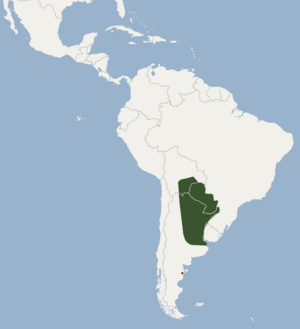Patagonian bonneted bat facts for kids
Quick facts for kids Patagonian bonneted bat |
|
|---|---|
| Conservation status | |
| Scientific classification | |
| Genus: |
Eumops
|
| Species: |
patagonicus
|
 |
|
| Synonyms | |
|
|
The Patagonian bonneted bat (Eumops patagonicus) is a type of free-tailed bat. It is also known as the Patagonian dwarf bonneted bat. These bats live in parts of Argentina, Bolivia, and Paraguay.
About Its Name and Family
This bat was first described as a new species in 1924. A British zoologist named Oldfield Thomas gave it its scientific name. He got the first bat specimen, called a holotype, from an Argentinean-Italian scientist named Roberto Dabbene. Mr. Dabbene was working in Buenos Aires at the time.
The bat's species name, "patagonicus", means "belonging to Patagonia". This is a region in South America. For many years, from about 1932 to the 1990s, scientists thought this bat was a subspecies of the dwarf bonneted bat (Eumops bonariensis). But later studies showed it is its own unique species.
The Patagonian bonneted bat belongs to a group of bats called the bonariensis species group. Other bats in this group include the dwarf bonneted bat, E. delticus, and E. nanus.
What Does It Look Like?
This bat is one of the smaller members of its bat family. Its forearm, which is part of its wing, is about 44 mm (1.7 in) long. Its head and body together measure about 54 mm (2.1 in). The tail is about 31 mm (1.2 in) long. Its ears are about 14.5 mm (0.57 in) long.
Where Does It Live?
The Patagonian bonneted bat lives in several countries in southern South America. You can find it in Argentina, Bolivia, and Paraguay.
Is It Safe?
The IUCN (International Union for Conservation of Nature) has evaluated the Patagonian bonneted bat. They have listed it as a least-concern species. This is the lowest conservation priority. This means scientists are not worried about it becoming endangered soon.
It has a large area where it lives. Also, its population is likely very big. Scientists do not think its numbers are quickly going down.
See also
 In Spanish: Eumops patagonicus para niños
In Spanish: Eumops patagonicus para niños


